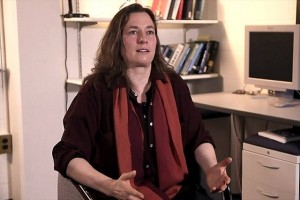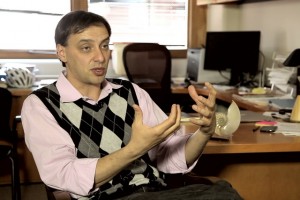The Dynamic Casimir Effect
Physicist Susanne Yelin on mirrors in a laser cavity, nano-optomechanics, and creating photons out of nothing ...
In 1971, two Americans, Aisenberg and Chabot published a paper in the Journal of Applied Physics. They used in the title of the paper the phrase ‘diamond-like carbon’. So, its carbon that is similar to diamonds. This was the first paper that started a large research field, since 1971 to nowadays so over 40 years, almost 50 years. Diamond-like carbon is now applied almost everywhere. Everybody was listening to this, is using it, but they don’t know. I want to make one particular example which is the R disk. Of course, the R disk has a part of it which is the magnetic part because of the magnetic storage. What people probably do not know, that is a very important part of the R disk, is the coating that is on the top of the magnetic disk and on the bottom of the reading head.
A modern R disk can store 1 terabit of information per square inch. What is limiting the amount of information you can store inside an R disk is the dimension of the bit. The more you make your bit smaller of course, the more you can put in the same space. But if it’s too small what happens is called the superparamagnetic limit. You have the electron spins that are all aligned let’s say when you write one but if the weight is too small, thermal excitation will just dis-align them. So, you will use your information very quickly over time. It cannot be stored for ten years or whatever the industry standard is.
So, what happened is, originally from the 1950s where this technology started – I don’t know if you remember but in the 1950s and 60s, a 5-megabyte hard-drive was the size of a modern car. In the 1970s 200 / 300 megabytes were more or less the size of a person. Nowadays if you go to any shop and you buy crisps they give you as a gift some data storage for one terabyte. Of course, that is a joke it’s not the case, but you need to realize how things changed. Originally, the distance between the reading head and the hard-drive was very very large, orders of tens of nanometers and the bits where written along the surface of the magnetic disk. So, like my arm, they were very long and thin. Then they started reducing the distance between the reading head and the surface of the drive and they became smaller. Maybe like my finger or the top of my finger. But they were still, with this shape, long and thin. They’re weak, if you approach too much they become too small and you cannot store the information.
And that is what happens, you have what is called perpendicular recording. I can put 10 times more information on the same space. That allowed us to reach what we have now on the market, one terabit per square inch. That requires a distance between the reading head and the surface of the hard-drive of only between two and three nanometres. This is about the thickness of 10 layers of graphene, so it is an extremely small distance.
On the top of it, the reading head is not kept in position by a mechanism or anything it is literally flying on the top of the surface of the hard-drive. So, when the hard-drive spins like a plane it takes off, it flies like an airplane. It’s actually exactly what happens, that is flying like an airplane. And like an airplane, it lands and takes off. So, what you need is a runway. The plane has to be able to land and take off, land and take off. The surface of the runway cannot be destroyed every time the plane takes off or lands. That’s why you need this diamond-like carbon. A carbon coating which is similar to diamonds, very strong but protects the magnetic part of the disk and allows landing and take-off all the time. On top of it, you don’t want the magnetic part of the disk to be affected by corrosion acids and all sorts of environments. So, it has to be very dense, very compact in order to avoid corrosion or damage to the surface of the magnetic part of the R disk. this is the challenge that diamond-like carbon has been facing for the past 40 years.
Now we are stuck. We are at one terabit per square inch. We cannot make it smaller with the current magnetic technology. So, there is another challenge we are facing, how do we go from one terabit per square into ten terabits or fifty terabits per square inch. One solution is to make sure that the spins stay together more closely or with more force that they do at the moment. We need a material that is so-called harder, a harder magnetic material, higher coercivity which means that the interaction between the spins is much stronger than what we have at the moment so it’s much harder to dis-align them. But there is a problem because in the R disk we need to write and erase information. In order to write and erase we need a magnetic field. If the bits are so hard to dis-align they will be so much harder to write and erase. We will need to put a massive magnetic field inside our storage devices. That is not realistic. So, people have now come up with a solution that is called ‘heat-assisted magnetic recording’. You take a magnetic material with much higher coercivity so you can make bits that are much smaller but then in order to write and erase your magnetic field has to be supplemented by a laser. The laser will heat, for a very small fraction of time, the surface of the disk. You will be able to write and erase with a small magnetic field and then it cools now.
So, this is an example of how this technology of diamond-like carbon started in the 1970s is now present in 1 billion, not million, billion, R disks that are produced every year. Another example that people may not know, razor blades. I don’t want to specify what brand but the major brands of razor blades have the blade coated with about one micron of diamond-like carbon because it improves the performance with it comes to shaving. Another possible application of this material is the coating of plastic bottles in order to store beer in plastic bottles instead of storing it in glass bottles or metal bottles. And again, the properties of this material initiation in the 1970s are now widely applied.
If we look at diamond-like carbon and graphene from the point of view of theory, there’s a big difference. Diamond-like carbon is an amorphous material so you don’t simply have two atoms per unit like in the case of graphene. So, many calculations in graphene can be done by hand or by the computer but you need to deal with a very small unit cell. When it comes to diamond-like carbon you need to do molecular dynamics; you need to do extremely heavy calculations with super-computers in order to understand what is going on. And often you are limited to 60 or 100 atoms that you can study and not even a cell. So, the theoretical challenges in amorphous carbon are much much bigger than the ones that we have in graphene. Many of them have been left unsolved.
What happens is over the years because it is too difficult to do fundamental theory, people have done semi-empirical approaches. So, they’ve taken some experimental data and some general principles of theory and constructed correlations that people can use. Most of these correlations are not fully understood. For example, in the past 2 or 3 years with the collaboration of IBM in Switzerland, theoretical calculations have been done in diamond-like carbon to understand how to utilize this material to store information directly. So, unlike the R disk where the carbon is a coating you can also directly create resistive memories in diamond-like carbon. You can do that by applying a voltage and creating conductive filaments within the insulating matrix of the diamond-like carbon. The theory of how this filament is created, and especially how the filament is removed when you write and rewrite is not concluded and requires very sophisticated tools of investigation in order to get to a reasonable picture of what is going on at the moment

Physicist Susanne Yelin on mirrors in a laser cavity, nano-optomechanics, and creating photons out of nothing ...

MIT Associate Prof. Leonid Mirny on the levels of complexity in biology, Fokker–Planck equations, and structur...

A first ever self-powered pump made of liquid metal was demonstrated, paving the way for making dynamically re...